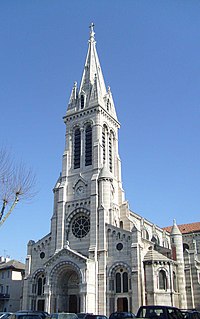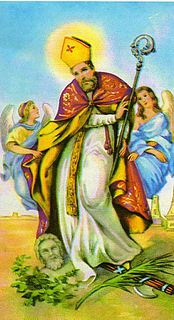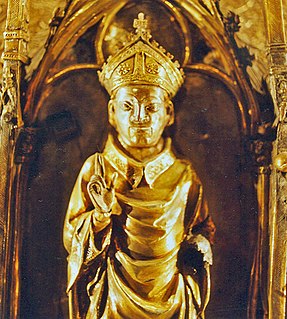Related Research Articles
Year 305 (CCCV) was a common year starting on Monday of the Julian calendar. At the time, it was known as the Year of the Consulship of Constantius and Valerius. The denomination 305 for this year has been used since the early medieval period, when the Anno Domini calendar era became the prevalent method in Europe for naming years.

Vincent de Paul, commonly known as Saint Vincent de Paul, was a French Catholic priest who dedicated himself to serving the poor. In 1622 Vincent was appointed a chaplain to the galleys. After working for some time in Paris among imprisoned galley slaves, he returned to be the superior of what is now known as the Congregation of the Mission, or the "Vincentians". These priests, with vows of poverty, chastity, obedience, and stability, were to devote themselves entirely to the people in smaller towns and villages. Vincent was zealous in conducting retreats for clergy at a time when there was great laxity, abuse, and ignorance among them. He was a pioneer in clerical training and was instrumental in establishing seminaries, and founder of the Congregation of the Mission and Daughters of Charity of Saint Vincent de Paul.
Saint Vincent may refer to:

Saint Vincent of Saragossa, the Protomartyr of Spain, was a deacon of the Church of Saragossa. He is the patron saint of Lisbon and Valencia. His feast day is 22 January in the Roman Catholic Church and Anglican Communion and the Orthodox Church, with an additional commemoration on 11 November in the Orthodox Church. He was born at Huesca and martyred under the Emperor Diocletian around the year 304.

Embrun, UN/LOCODE: CA EBU, is a community in the Canadian province of Ontario in the Eastern Ontario region. Embrun is also part of the National Capital Region. Embrun is part of the larger Russell Township in Prescott and Russell United Counties. In 2011, the urban area of Embrun had a total population of 6,380, but if surrounding agricultural areas closely tied to the community are included, the population figure rises to 8,669. This makes Embrun the largest community in the Township of Russell.

April 19 - Eastern Orthodox liturgical calendar - April 21

The Diocese of Gap and Embrun is a Latin Church ecclesiastical territory or diocese of the Catholic Church in Provence-Alpes-Côte d'Azur region of Southern France.

Saints Nazarius and Celsus were two martyrs of whom nothing is known except the discovery of their bodies by Saint Ambrose.
Saint Orontius may refer to:

Embrun Cathedral is a Roman Catholic church and former cathedral located in the town of Embrun, Hautes-Alpes, France.

Vincent is a male given name derived from the Roman name Vincentius, which is derived from the Latin word vincere.

The Roman Catholic Archdiocese of Embrun was located in southeastern France, in the mountains of the Maritime Alps, on a route that led from Gap by way of Briançon to Turin. It had as suffragans the Diocese of Digne, Diocese of Antibes and Grasse, Diocese of Vence, Diocese of Glandèves, Diocese of Senez and Diocese of Nice. Its see was the Cathedral of Nôtre Dame in Embrun.

Saint-André-d'Embrun is a commune in the Hautes-Alpes department in southeastern France. Surrounded by the towns of Chateauroux-les-Alpes, Embrun and Crévoux, Saint-André-d'Embrun is located 36 km northeast of Gap, the largest city nearby.

Saint Orontius of Lecce is venerated as a saint by the Roman Catholic Church, along with two other figures associated with his legend, Fortunatus and Justus. He is viewed as the first bishop of Lecce.
Orontius is a name of Latin origin. It can refer to:

Saint Palladius of Embrun was a 6th-century bishop of Embrun. Born to a Christian family, he studied under Catulin, bishop of Embrun, who had attended the Council of Épaone in 517. When the Arians and Sigismund of Burgundy opposed the council, Catulin was exiled to Vienne. Palladius accompanied him there, and took the opportunity to extensively study Scripture. Palladius was ordained a priest and, according to legend, gained the gift of prophecy. He is said to have predicted the fall and death of Sigismund. Catulin died around 518, and Palladius would later be elected bishop of Embrun. During his episcopate he built numerous churches, in Chorges, Sauze, and Rama, as well as sanctuaries dedicated to Saint Martin of Tours, and Saints Vincent, Orontius, and Victor, as well as to Genesius of Arles. One source states that Palladius "possessed an exceptional efficacy in obtaining whatever he petitioned God for." Many miracles were attributed to him, and, besides the gift of prophecy, he enjoyed a "mystical familiarity with the angels... [and] successfully defeated the machinations of the devil simply by making the sign of the cross."
Conseil scolaire de district catholique de l'Est ontarien is the Roman Catholic separate, French language school board for the Southeastern region of Ontario. It is headquartered in L'Orignal, a largely French-speaking town in eastern Ontario, and serves the counties of Prescott and Russell and Stormont, Dundas and Glengarry. This school board has 32 schools in total, including 7 secondary schools.
Gallicanus II was the ninth bishop of Embrun. He assisted at the Fourth Council of Orléans in 541 and was represented by a certain Probus at the fifth of Orléans. He is said to have consecrated a church dedicated to the Spanish martyrs Vincent, Orontius and Victor, which was built at Embrun by the previous bishop, Palladius. It is possible, however, that Palladius never existed—he is unknown except from some hagiographical documents of little value—and that Gallicanus II is the same person as Gallicanus I and governed the diocese from 518 until 549, and perhaps as late as 554.
Marcellinus of Gaul also known as Marcellin was the first bishop of Embrun from 354 AD. He was a native of Africa Proconsularis.